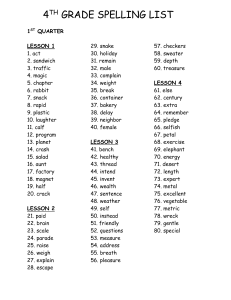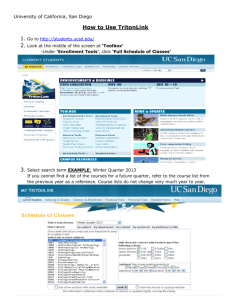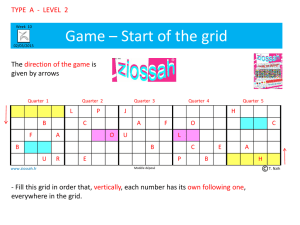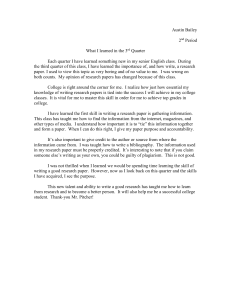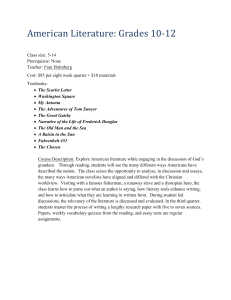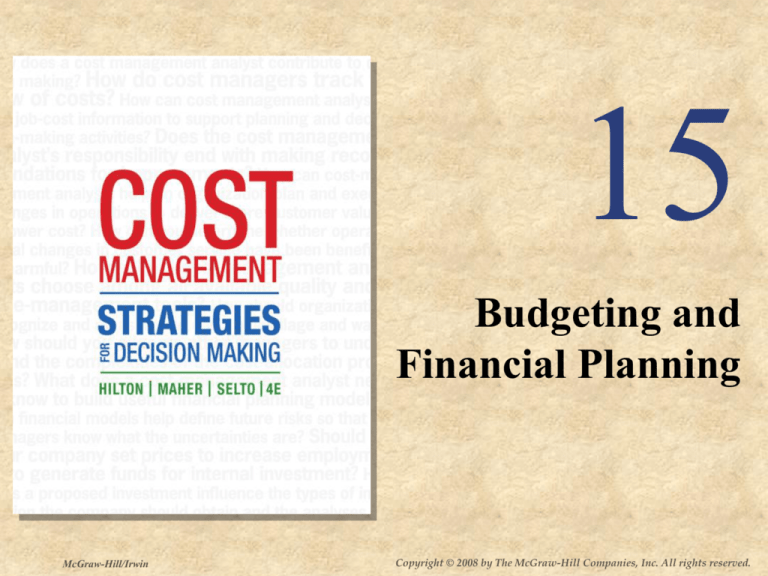
15
Budgeting and
Financial Planning
McGraw-Hill/Irwin
Copyright © 2008 by The McGraw-Hill Companies, Inc. All rights reserved.
15-2
Learning Objective 1
15-3
Strategic Planning
Critical success factors - Strengths of the
company that enable it to outperform
competitors.
Critical
Success
Factors
Incorporated Into
Strategic
Plan
15-4
Strategic Long-Range Plan
The master budget is part of an overall
organizational plan made up of three
components . . .
Organizational goals – management’s broad
objectives that employees work to achieve.
The strategic long-range profit plan – steps to
be taken to achieve organizational goals.
The master budget – tactical short-range profit
plan.
15-5
Learning Objective 2
15-6
Key Purposes of the Budgeting System
The five primary purposes are:
1.
2.
3.
4.
Planning.
Facilitating Communication and Coordination.
Allocating Resources.
Managing Financial and Operational
Performance.
5. Evaluating Performance and Providing
Incentives.
15-7
Organizations Use Many Types of
Budgets
Organization
Organization
goals
Individual
Long-range
strategic plan
Individual goals
and values
Anticipated
conditions
Individual
beliefs
Master
budget
Strategic
evaluation
Actual period
results
Performance
evaluation
15-8
Learning Objective 3
15-9
The Master Budget as a Planning Tool
After organization goals, strategies and longrange plans have been developed, work
begins on the master budget.
The master budget is a detailed budget for the
coming fiscal year.
2008
15-10
Sales Budget: The Starting Point
Sales Staff – close to customer needs.
Market Research – can predict long-term
trends in attitudes and the effects of social and
economic changes on the company’s sales,
potential markets and products.
Sales Forecasting – the process of predicting
sales of services or goods.
Let’s look at some forecasting tools.
15-11
Forecasting Tools
Delphi technique – the elicitation of forecasts
from individual group members, for
anonymous evaluation by the group as a
whole, in a search for convergence.
Econometric modeling – the use of various
economic indicators and market factors to
predict future sales, by means of regression
analysis.
15-12
Operational Budgets
Manufacturing firms – A production budget is
developed from budgets for direct materials,
direct labor and overhead. A budget for selling,
general and administrative (SG&A) expenses is
also prepared.
Merchandising firms – Instead of a production
budget, a budget of merchandise purchased is
developed. The SG&A budget is also prepared.
Service-industry firms – Based on the sales
budget for its services, a set of budgets is
developed for the resources to be used in
providing the services.
15-13
Operational Budgets
Every business prepares a . . .
1. Cash budget
2. Capital expenditures budget, and a
3. Summary of operational budgets
15-14
International Aspects of Budgeting
Firms with international operations face a variety of
additional challenges in preparing their budgets . . .
1. Translation of foreign currencies into local
currency.
2. Budget preparation is difficult when inflation (or
deflation) is high or unpredictable.
3. The economies of all countries fluctuate in
terms of consumer demand, availability of
skilled labor, and laws affecting commerce.
15-15
Activity-Based Budgeting
Activity-based budgeting (ABB) is the process of
developing a master budget using information obtained
from an activity-based costing (ABC) analysis
Resources
Activities
Forecast of products and
services to be produced,
and customers served.
15-16
Illustrating the Master Budget
Schedule
Title of Schedule
1
Sales Budget
2
Production Budget
3
Direct-Materials Budget
4
Direct-Labor Budget
5
Manufacturing Overhead Budget
6
Selling, General, and Administrative Expense Budget (SG&A)
7
Cash Receipts Budget
8
Cash Disbursements Budget
9
Cash Budget
10
Budgeted Schedule of Cost of Goods Manufactured and Sold
11
Budgeted Income Statement
12
Budgeted Balance Sheet
15-17
The Sales Budget
Detailed schedule showing expected
sales for the coming periods
expressed in units and dollars.
15-18
Sales Budget of Collegiate Apparel
Collegiate Apparel Company is preparing budgets for
the year ending December 31, 20x1.
Budgeted sales are:
First quarter
– 15,000 units
Second quarter – 5,000 units
Third quarter
– 10,000 units
Fourth quarter
– 20,000 units
The selling price is $12 per unit.
15-19
Sales Budget of Collegiate Apparel
15-20
Production Budget
Sales
Budget
Production
Budget
Plan of resources needed to meet current
sales demand and ensure inventory levels
are sufficient for future sales.
15-21
Forecasting Production
Rearrange the basic inventory formula as follows . . .
Units in
beginning
inventory
+
Required
production
in units
–
Sales
in
Units
=
Units in
ending
inventory
Now, solve for required production . . .
Units
to be
Produced
=
Sales
in
Units
+
Units in
ending
inventory
–
Expected
beginning
inventory
15-22
The Production Budget
Collegiate Apparel wants units in ending finished
goods inventory to be 10% of the next quarter’s
expected sales in units.
At the beginning of the year, 1,500 completed
units were on hand.
During the first quarter of 20x2, 15,000 units are
expected to be sold.
Let’s prepare the production budget.
15-23
The Production Budget
5,000 × 10% = 500 units
15-24
Direct-Materials Budget
Direct materials needed for the budget period
can be determined as follows . . .
Required
materials
purchases
=
Materials
used in
production
+
Ending
materials
inventory
–
Beginning
materials
inventory
15-25
Direct-Materials Budget
At Collegiate Apparel 1.5 yards of fabric are required
per unit of product.
Management wants fabric on hand at the end of each
quarter to be 10% of next quarter’s raw materials
required. On January 1st, 2,100 yards of fabric are onhand. During the first quarter of 20x2, Collegiate
expects 21,000 yards of fabric to be required.
Each yard of fabric cost the company $2.
Let’s prepare the direct materials budget.
15-26
Direct-Materials Budget
8,250 × 10% = 825 units
15-27
Direct-Labor Budget
At Collegiate Apparel, each unit produced
requires 0.20 hour (12 minutes) of direct
labor.
Workers earn a wage rate of $10 per hour
regardless of the hours worked. Collegiate
Apparel can hire workers as needed to
meet production.
Let’s prepare the direct labor budget.
15-28
Direct-Labor Budget
15-29
Manufacturing-Overhead Budget
Collegiate Apparel uses activity-based budgeting.
At the unit-level, each unit produced requires $0.25 of indirect
materials and $0.15 of electricity.
At the batch-level, the company expects the following
production runs:
1st quarter – 28
2nd quarter – 11
3rd quarter – 22
4th quarter – 39
At the product-level, the company expects two new style
designs each quarter with each new T-shirt design costing
$500.
Details of the facilities-level overhead costs are shown on the
manufacturing-overhead budget.
15-30
Manufacturing-Overhead Budget
Unit-, Batch-, and Product-level Portions of the Budget
15-31
Manufacturing-Overhead Budget
Product-, Facilities-level and Total Overhead Budget
$5,600 + $8,400 + $1,000 + $36,500 = $51,500
15-32
SG&A Expense Budget
At Collegiate Apparel, sales commissions
and freight-out are unit-level SG&A.
Customer-level SG&A expenses include
licensing fees for use of names and logos.
Facilities-level SG&A expense include sales
salaries, advertising and clerical wages.
Let’s prepare the SG&A expense budget.
15-33
SG&A Expense Budget
$
$
$
$
15-34
Cash Receipts Budget
At Collegiate Apparel all sales are made on
account.
The company collects 80% of its billings in the
quarter of the sale and 18% in the following
quarter. The remaining two percent of each
quarter’s sales are expected to be uncollectible.
Sales in the last quarter of 20x0 were $240,000.
Let’s prepare the Cash Receipts Budget.
15-35
Cash Receipts Budget
$240,000 × 18% = $43,200
$180,000 × 18% = $32,400
$180,000 × 2% = $3,600
15-36
Cash Payments for Direct-Materials
At Collegiate Apparel all purchases of raw
materials are made on account.
The company pays for 60% of its purchases in
the quarter of the purchase and the remaining
40% in the following quarter.
Purchases in the last quarter of 20x0 were
$56,850.
Let’s prepare the Cash Disbursements Budget.
15-37
Cash Payments for Direct-Materials
$39,450 × 40% = $15,780
$18,150 × 60% = $10,890
15-38
Other Cash Disbursements
15-39
Cash Budget
Collegiate Apparel started the year with a cash
balance of $10,000, and borrows $100,000 at the
beginning of 20x1 to finance plant expansion.
The loan is repaid in the amount of $25,000 at the
end of each quarter with interest on the unpaid
balance at 10%.
Payments for the plant additions were:
1st quarter
2nd quarter
3rd quarter
4th quarter
= $45,000
= $15,000
= $5,000
= $35,000
Let’s prepare the Cash Budget.
15-40
Cash Budget
$100,000 × 10% × ¼ = $2,500
15-41
Calculation of Absorption Unit Cost
15-42
Cost of Goods Manufactured and Sold
Budget
At Collegiate Apparel the production cycle is
short enough that it has no work-in-process
inventory at any time.
From Schedule 3 in the text, we know there are
2,100 yards of fabric at $2.00 per yard in
beginning raw material inventory.
And from Schedule 2 we know there are 1,500
units in ending finished goods inventory. We just
computed the absorption cost per unit at $9.00.
Let’s prepare the Cost of Goods Manufactured
and Sold Budget.
15-43
Cost of Goods Manufactured and
Sold Budget
2,100
× $2
$4,200
1,500
× $9
$13,500
15-44
Budgeted Income Statement
15-45
Budgeted Balance Sheet
The balance in the building account on December 31,
20x0 was $400,000, and the balance in the equipment
account was $320,000. Total accumulated
depreciation was $240,000. Depreciation expense is
recorded at the rate of $60,000 per year.
At December 31, 20x1, the company had a long-term,
noninterest-bearing note payable of $200,000. The
note is due on December 31, 20x3.
The balance in the owners’ equity account at
December 31, 20x0, was $330,160.
Supplies on hand at December 31, 20x1 were $2,000.
Let’s prepare the Budgeted Balance Sheet.
15-46
$240,000
× 18%
$43,200
$56,850
× 40%
$22,740
$330,160
56,750
$386,910
15-47
How It All Fits Together
Production
budget
Sales forecast
SG&A
budget
15-48
How It All Fits Together
Production
budget
Required direct
materials, labor
and mfg. overhead
budgets
Sales forecast
SG&A
budget
Budgeted
income
statement
15-49
How It All Fits Together
Production
budget
Required direct
materials, labor
and mfg. overhead
budgets
Sales forecast
SG&A
budget
Budgeted cost
of goods mfg.
and sold
Budgeted
income
statement
15-50
How It All Fits Together
Production
budget
Required direct
materials, labor
and mfg. overhead
budgets
Sales forecast
SG&A
budget
Budgeted cost
of goods mfg.
and sold
Budgeted
income
statement
Cash budget
Budgeted balance
sheet
15-51
Learning Objective 4
15-52
Responsibility for Budget
Administration
Budget Committee – Consists of key senior
executives who may advise the budget director
during the preparation of the budget.
The authority to give final approval to the budget
usually rests with the board of directors.
15-53
Learning Objective 5
15-54
Budgetary Slack: Padding the Budget
Padding the budget means intentionally
underestimating revenues or overestimating
costs.
The difference between the revenue or cost
projection that a person provides and a
realistic estimate of the revenue or cost is
called budgetary slack.
A solution: reward managers for making
accurate estimates.
15-55
Participative Budgeting
Participative Budgeting – the use of input from
lower- and middle-management employees.
The process is time consuming but enhances
employee motivation and acceptance of
goals.
15-56
Ethical Problems in Budgeting
Much of the information for the budget is
provided by persons whose performance is
then compared with the budget they help
develop.
Let’s prepare the
sales forecast with a
4% increase, so we
will really look good!
I think sales
will increase by
10% next year.
15-57
Zero-Based Budgeting for Discretionary
Costs
A system of establishing financial plans
beginning with an assumption of no activity
and justifying each program or activity level.
After some initial success, zero-based
budgeting was found to be impractical.
Massive amounts of time were required to
implement and update the budget.
15-58
Learning Objective 6
15-59
Contemporary Trends in Budgeting
and Financial Planning
The emerging concept of financial planning is
gradually replacing a budgeting process in which
remote sales projections drive decisions and push
costs onto inventory.
The process is more customer-driven, not by largescale sales statistics but by specific orders. The
budgeting process is adapting to this sales model.
In cost management, costs “don’t just happen” but
are actively managed with techniques such as
activity-based management. Activities are reviewed
for the value they add to products and services.
15-60
Beyond Budgeting
A break from the budgeting process already
shown, based on the growing need to satisfy
customers and relying on a company’s
intellectual assets.
This approach emphasizes:
rolling forecasts and optimization of resources
no evaluation on meeting specific targets
decentralized decision making and teams
a climate based on sustained competitive success
transparent and open information systems
15-61
Learning Objective 7
15-62
Inventory Management –
Economic Order Quantity
“How much inventory to keep on hand?”
Inventory decisions involve a delicate balance
between these classes of cost:
√
ordering costs
holding costs
shortage costs
EOQ is a mathematical tool to determine
the order quantity that minimizes the
ordering and holding costs:
15-63
Inventory Management under JIT
Under JIT, there would be no inventories
at all! Inventory cost would be wasteful.
In fact, as inventory holding costs are
reduced, so is EOQ.
So, order as needed. There is no ideal
order quantity.
15-64
End of Chapter 15



